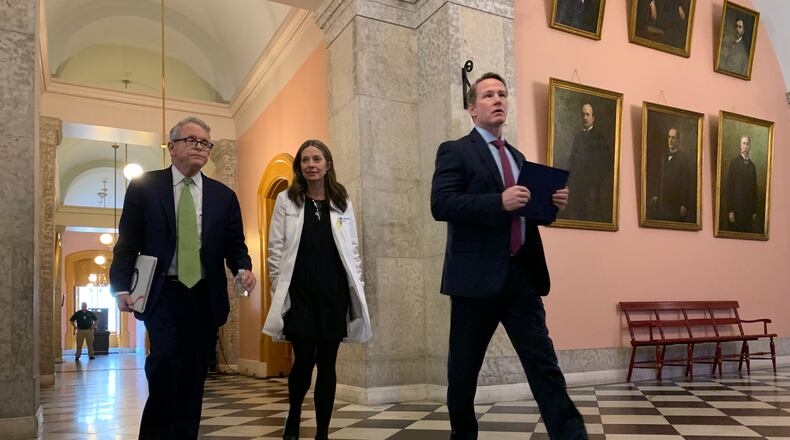“We have got to clamp down even more. We have got to stay home. We can’t go in the other direction right now,” said Dr. Amy Acton, director of the Ohio Department of Health. “Ohio, what you’re doing is absolutely saving lives.”
Projections show that the steps Ohio has taken — closing schools and businesses and residents largely staying at home — is helping flatten the pandemic curve, she said. But there is no scenario in which Ohio won’t see a surge of cases by late April to mid-May, she said Thursday.
Ohio’s confirmed cases hit 867 with 223 hospitalized, including 91 in intensive care units, the state reported Thursday. The death toll in Ohio hit 15.
Ohio Department of Job and Family Services reported 187,780 initial jobless claims to U.S. Department of Labor. A week earlier, the state had reported 7,042 claims.
Lt. Gov. Jon Husted said the state’s unemployment compensation website received 1.7 million hits in the past five days and he assured workers that benefits would be retroactive.
>> COVID-19: Where are cases, deaths worst in U.S. and Ohio?
Nationwide, seasonally adjusted initial claims reached 3,283,000, an increase of 3,001,000 from the previous week’s revised level, the U.S. Department of Labor said Thursday.
“The shocking number of unemployment claims this week underline the risk of a corona-depression. We estimated last week that 104 million workers would lose income in the next 45 days; a good number of them already have,” said Patrick Anderson, chief executive of Michigan-based market analysis firm Anderson Economic Group.
DeWine said it’s possible that Ohio’s 1.7 million K-12 school children won’t return to the classrooms this academic year.
This week, state lawmakers passed an emergency bill that addresses several coronavirus crisis related problems. It’ll bump the state income tax filing deadline to July 15, waive K-12 testing and high school graduation requirements and give more flexibility to Ohio’s unemployment compensation system so workers can file for benefits immediately and not be required to look for work while receiving checks.
>> Ohio cancels school testing, sets graduation and voucher rules: 7 things to know about changes
DeWine said he plans to sign the bill into law on Friday.
While the economy stumbles, Ohio is bracing for the full impact of the coronavirus on the health care system.
Shortages of precious resources — personal protective equipment, N95 masks and ventilators — are a major concern. Acton said the shortages could put doctors in the position of deciding who gets a ventilator and who does not, even when that could contribute to one patient’s death.
“This is the thing that is keeping me awake at night,” said Acton. She added, “There is, in the world of health preparedness, an ongoing dialog about this. These are ethical, difficult decisions.”
“We are doing everything we can to avoid that and that’s why we’re asking Ohioans to follow the orders, follow the suggestions so we can do everything we can to slow this thing down,” DeWine said.
The risk that some hospitals across the county may have to to ration ventilators will depend on the pace of the pandemic and how many patients need them at the same time, according to 'The Toughest Triage — Allocating Ventilators in a Pandemic' published in the New England Journal of Medicine.
>> 3.28M filed for jobless claims, reaching new record
The authors wrote: “Many states have developed strategies for rationing during pandemics. The New York guidelines target saving the most lives, as defined by the patient’s short-term likelihood of surviving the acute medical episode.”
The authors recommended that clinicians and families of high-risk patients hold discussions about intubation decisions before their health deteriorates and that triage committees be established to remove the burden of life-and-death decisions from bedside doctors.


